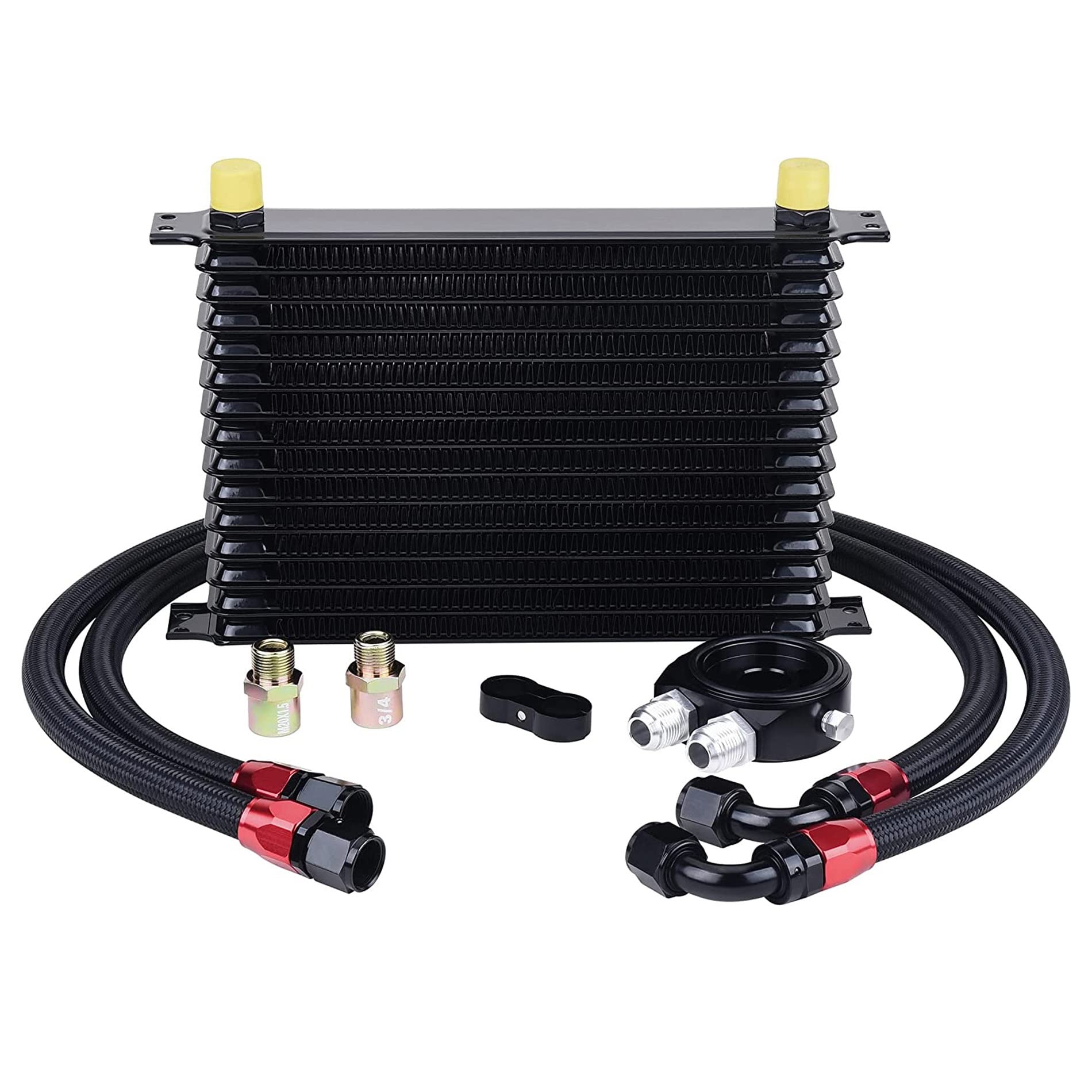Brake failure is every driver’s nightmare. The sudden loss of braking power can be terrifying and dangerous, but with the right knowledge and techniques, it is possible to navigate such a situation safely. Being prepared and informed is crucial in these moments. This comprehensive guide will equip you with strategies to handle brake failure effectively, ensuring your safety and that of others on the road.
Understanding Brake Systems

Before diving into survival strategies, it’s essential to understand how your vehicle’s braking system operates. Most cars have hydraulic brake systems, where brake fluid creates pressure to engage the brakes. If this system fails, whether due to a leak, mechanical issue, or other factors, it can lead to a loss of braking power.
Also Read: Top 10 Best Engine Oil Cooler Kit In Review: Buying Guide
Recognizing Brake Failure
Knowing the signs of potential brake failure is vital. If you notice any of the following symptoms, it’s crucial to take immediate action:
- Spongy Brake Pedal
If the brake pedal feels soft or spongy, it could indicate a brake fluid leak or air in the brake lines.
- Unusual Noises
Grinding, squeaking, or metallic sounds when applying brakes might suggest worn brake pads or other mechanical issues.
- Vibrations or Pulling
When braking, if the vehicle vibrates or pulls to one side, it might indicate a problem with the braking system.
What to Do When Faced with Brake Failure
1. Stay Calm
Remaining calm is the most crucial aspect when facing brake failure. Panic can cloud judgment and lead to poor decision-making. Take deep breaths and focus on handling the situation calmly and rationally. Keeping a clear mind is the first step to handling this emergency.
2. Warn Others and Signal
Use hazard lights to alert other drivers of your situation. If your brakes are failing, gently tap the brakes several times to alert drivers behind you. Then, use hand signals to indicate your intention to slow down or pull over. Notifying others about the issue is essential for creating a safer environment for everyone on the road.
3. Look for a Safe Place to Stop
Scan your surroundings for a safe area to bring the vehicle to a stop. Search for open spaces, downhill roads, or emergency lanes. Gradually reduce speed and maneuver your car safely to the side of the road. Finding a secure spot to halt is crucial for your safety and the safety of others.
4. Utilize Safe Driving Techniques
Employ the ‘heel-toe’ technique. Use your heel to apply the brakes and your toes to accelerate. This method helps you control speed more effectively when faced with brake failure, offering a means to manage the vehicle’s momentum.
5. Avoid Abrupt Movements
Refrain from sudden steering or rapid acceleration as these actions could exacerbate the situation. Make slow, deliberate movements to maintain control of the vehicle. Smooth and careful maneuvers are crucial in managing a vehicle experiencing brake failure.
6. Downshift or Use Emergency Brake
If you are driving a manual transmission vehicle, downshifting to lower gears can help gradually slow down the car. For automatic vehicles, applying the emergency brake cautiously and progressively can assist in reducing speed. These techniques offer a way to mitigate the loss of braking power.
Preventative Measures and Maintenance Tips
Regular brake maintenance is an integral part of ensuring your vehicle’s safety on the road. Following these key tips can significantly decrease the likelihood of brake failure:
-
Regular Inspections
Scheduling regular inspections for your vehicle’s braking system is crucial. Having a professional examine the brakes at recommended intervals set by the manufacturer ensures that potential issues are identified and addressed before they become critical. Timely inspections can help in detecting worn-out brake pads, leaks, or other potential problems, preventing brake failure.
-
Brake Fluid Checks
Regular checks and maintenance of brake fluid are essential for optimal brake performance. Ensure that the brake fluid is at the proper level and contamination-free. Over time, brake fluid can absorb moisture, reducing its effectiveness. Follow the manufacturer’s recommendations for changing the brake fluid, which is typically every few years, to maintain the system’s efficiency and prevent brake failure.
-
Brake Pad Replacement
The brake pads are crucial components that ensure the braking system’s effectiveness. Regularly inspect and replace brake pads as soon as signs of wear are noticed. Worn-out brake pads can cause damage to the braking system and compromise your ability to slow or stop the vehicle. Following the manufacturer’s guidelines for the lifespan of brake pads and promptly replacing them when necessary is vital for preventing brake failure.
In addition to these key measures, it’s beneficial to maintain an awareness of the broader condition of your vehicle. Regular servicing, checking other components like brake rotors, calipers, and brake lines, and addressing any unusual sounds or sensations while braking can help preemptively identify issues that might lead to brake failure.
Moreover, practicing safe driving habits can contribute to the longevity and effectiveness of your vehicle’s braking system. Avoid abrupt stops, reduce excessive speeding, and refrain from aggressive driving, as these actions can wear down the brakes more quickly and potentially lead to failure.
Remember, a proactive approach to brake maintenance, adhering to manufacturer recommendations, and promptly addressing any signs of wear or malfunction will not only ensure your safety but also enhance the performance and longevity of your vehicle’s braking system.
By incorporating these preventative measures and maintenance tips into your regular vehicle care routine, you can significantly reduce the risks of brake failure, ensuring a safer and more reliable driving experience for you and those sharing the road.
Additional Steps you can take to Enhance your Preparedness
Being prepared for emergencies beyond just knowing how to handle brake failure is paramount for ensuring your safety on the road. Here are additional steps you can take to enhance your preparedness:
-
Emergency Kit
Keeping an emergency kit in your vehicle is a crucial safety measure. Your emergency kit should include essential items such as reflective triangles to warn other drivers of your stopped vehicle, a flashlight for visibility in low-light conditions, a first aid kit for minor injuries, and basic tools for small repairs. These items can prove invaluable in various emergency situations, not only during brake failure but also in case of other unexpected roadside issues.
-
Driver Training
Consider enrolling in defensive driving or emergency handling courses to enhance your skills and readiness in unexpected situations. These courses can provide you with invaluable knowledge and techniques to manage emergency scenarios efficiently. They cover various defensive driving tactics, emergency maneuvers, and techniques to handle vehicle malfunctions, including brake failure. Such training can significantly bolster your confidence and capability in dealing with challenging situations on the road.
-
Insurance Coverage
Ensure that your insurance policy covers roadside assistance or towing in case of emergencies. This coverage can be a lifesaver in situations like brake failure or any other breakdown. Confirm the extent of coverage and understand the procedures for availing these services. Roadside assistance can include services like towing, fuel delivery, battery jump-starts, and even minor repair assistance, offering peace of mind and practical help during stressful situations.
Vehicle Maintenance for Safe Driving
-
Regular Maintenance Checks
Regular maintenance checks encompass inspecting essential vehicle components such as brakes, tires, engine, lights, fluids, and steering. These routine checks are vital to ensuring the vehicle operates optimally and reducing the risk of unexpected malfunctions. For instance, consistent brake inspections can detect early signs of wear, preventing potential brake failures and supporting road safety.
-
Tire Safety
Proper tire maintenance is critical for vehicle stability and braking efficiency. Regular checks for tire pressure, tread wear, and maintaining appropriate inflation levels are essential. Adequate tire care not only supports safe driving but also directly affects braking performance, making it a crucial factor in ensuring a safe and reliable braking system.
-
Fluid Levels and Quality
Maintaining proper levels and quality of various fluids including engine oil, brake fluid, transmission fluid, coolant, and windshield washer fluid is vital for the vehicle’s smooth functioning. Regular fluid checks and maintenance are imperative as neglecting these can lead to issues like brake failure. Proper maintenance ensures the braking system operates optimally, thereby enhancing overall safety.
-
Battery and Electrical System
A well-maintained battery and electrical system are crucial for the vehicle’s reliability and functionality. Regular checks and maintenance of the electrical components ensure the system operates effectively, impacting the vehicle’s ability to respond in emergency situations, including effective braking. Understanding common signs of battery issues and timely maintenance are key to preventing potential malfunctions.
-
Lighting and Signals
Proper functioning of external vehicle lights such as headlights, brake lights, and turn signals is pivotal for visibility and communication on the road. Regular checks and maintenance of these lights are essential for safe driving and emergency handling. Properly functioning lights are critical in ensuring the safety of the driver and other vehicles on the road.
-
Alignment and Suspension
Maintaining proper alignment and suspension directly contributes to vehicle control, stability, and braking efficiency. Ensuring these aspects are well-maintained significantly supports effective braking systems. Regular alignment checks and proper suspension maintenance are crucial in reducing the risk of potential brake-related issues and supporting overall road safety.
FAQs: How To Survive Brake Failure?
How do you survive a brake failure?
Survival in the event of brake failure depends on remaining calm and using alternative strategies to slow down the vehicle. Following emergency protocols, using gears, and seeking a safe place to stop are crucial steps.
What is the first step in case of brake failure?
The initial step in the event of brake failure is to remain calm. Warn others by using hazard lights, tap the brakes gently, downshift if possible, and find a safe spot to pull over.
What are proper braking techniques?
Proper braking techniques involve gradual and controlled application of the brakes. Additionally, techniques like the ‘heel-toe’ method or using the emergency brake cautiously can aid in slowing down the vehicle safely.
How do you brake safely while driving?
Safe braking involves maintaining a safe following distance, anticipating stops, and applying brakes smoothly and progressively to avoid abrupt stops.
What is the first strategy you should try if your brakes fail?
Initially, try downshifting to lower gears or use the emergency brake cautiously to reduce speed gradually.
What are the main causes of brake failure?
Main causes of brake failure include worn brake pads, brake fluid leaks, air in the brake lines, or mechanical malfunctions within the braking system.
How do you stop a bus when brakes fail?
If bus brakes fail, use emergency procedures, such as engaging in low gears, utilizing the emergency brake, and aiming for a safe area to reduce speed and stop.
What happens during a brake failure?
During brake failure, the brake system loses its ability to slow or stop the vehicle. This can result in a lack of responsiveness when pressing the brake pedal.
What to do if your brakes fail while driving Reddit?
Responses on Reddit often advise remaining calm, downshifting, and engaging the emergency brake carefully while searching for a safe place to stop.
Can you use the handbrake if brakes fail?
In emergency situations where brakes fail, cautiously using the handbrake can help slow down the vehicle, but it’s essential to use it gradually and avoid abrupt maneuvers.
Conclusion
Preparation and proactive maintenance are paramount in addressing brake failure emergencies. Recognizing warning signs, regular maintenance checks and preparedness through driver training and emergency kits play crucial roles in mitigating risks. Remaining calm and implementing alternative braking techniques are vital during emergencies. By emphasizing safety, maintenance, and preparedness, drivers can significantly reduce the risks associated with brake failure, ensuring a safer and more secure driving experience for all on the road.




